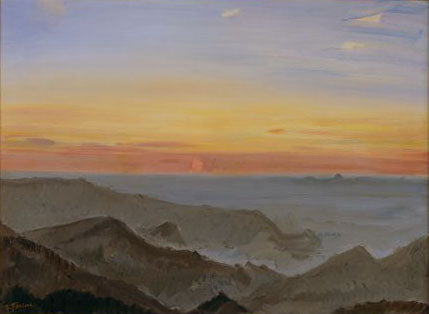Popis
Fujishima Takeji’s Sunrise from the Mountain Top (1934) is a masterful example of the artist’s ability to fuse elements of the Japanese landscape with a modernist approach. Housed in the National Museum of Modern Art in Kyoto, this painting offers a stunning visual representation of the natural splendor surrounding the human figure, encapsulating a moment of transition—the sunrise—that symbolizes both a new beginning and the human connection to the environment.
From the first glance, the composition reveals a scene where the mountain, represented in an imposing foreground, echoes the grandeur of the Japanese landscape. The use of colour is fundamental in this work: the orange and yellow tones of the sky contrast beautifully with the deep blue of the horizon and the shadows of the mountain. This palette not only breathes life into the image, but also evokes the serenity and majesty that are associated with sunrises in the Japanese pictorial tradition. The arrival of the sun, balancing light and shadow, becomes a visual metaphor that suggests the revelation of beauty in the everyday.
The work is a significant piece within the context of Nihonga, a style of Japanese painting that, over time, has incorporated both traditional techniques and modern elements, achieving a dialogue between the ancient and the contemporary. Fujishima Takeji, one of the most prominent representatives of this movement, demonstrates in "Sunrise From The Mountain Top" his mastery in the use of traditional materials and techniques that provide a rich and complex texture to the surface of the canvas. The kakejiku, or vertical scroll used in landscape painting, is observed in the way the scene is structured, while a modern perspective is incorporated that gives it depth and interesting dimensions.
Unlike many works that incorporate human figures, in this painting the presence of characters is absent, allowing the landscape to speak for itself. It is as if the intimacy of the moment—the spiritual experience of witnessing the sunrise—is the only thing needed to be shared with the viewer. The choice not to include figures allows for a greater immersion in the contemplation of the landscape and highlights the interrelationship between humans and nature, a recurring theme in Japanese art.
Looking deeper into the work, one cannot help but be drawn to the attention to detail and the delicacy in the depiction of light and surroundings. The nuances of the sky, the play of light cast on the mountain tops, and the soft contours of the land offer an almost ethereal feel. This approach resonates with many of the aesthetic principles of nature in Japanese art, where the beauty of imperfection and transience are celebrated through representation.
Fujishima Takeji, throughout his career, addressed a variety of themes and contexts in his work, however, “Sunrise From The Mountain Top” remains an iconic work that encapsulates his creative genius. It is not only a testament to his technical ability, but also to his deep love and respect for nature, a theme that is essential to Japanese culture and perpetuated in classical and contemporary art.
In conclusion, the painting not only offers us a stunning view of the Japanese landscape, but also invites us to reflect on our relationship with the natural world and the moments of calm found in the transition between day and night. “Sunrise From The Mountain Top” is a visual reminder of the beauty that surrounds us and how art can capture the pure essence of such experiences.
KUADROS ©, a famous painting on your wall.
Hand-made oil painting reproductions, with the quality of professional artists and the distinctive seal of KUADROS ©.
Painting reproduction service with satisfaction guarantee. If you are not completely satisfied with the replica of your painting, we will refund 100% of your money.

